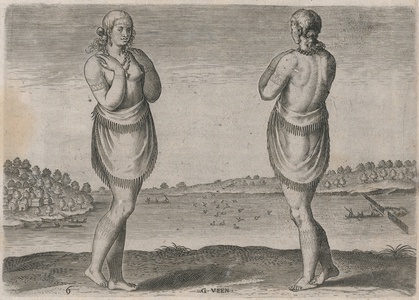| Method | Copper engraving |
| Artist | Gijsbert van Veen after John White |
| Published | [Amsterdam, c.1590] |
| Dimensions | Image and Plate 150 x 212 mm, Sheet 330 x 238 mm |
| Notes |
A full length portrait, front and back, of a young Roanoke woman, engraved by Gijsbert van Veen after a watercolour by the English colonial governor and cartographer John White. In the image, the young woman, described in the caption as of noble birth, stands with her hands on her shoulders, covering her breasts in an attitude of modesty, and wearing a tassled skirt of deer skin, and jewellery made of strings of pearls. Her hair is cropped into a fringe at the front and tied into a knot at the nape of her neck. Her arms, legs, and face are decorated with tattoos. She stands on the bank of a large lake, beyond which can be seen a settlement, possibly the Roanoke town of Secotan, and on the lake, figures fish from canoes and navigate a palisade, perhaps a fence fence, in the middle of the water. The particular example is from the 2nd German edition of the first part of de Bry's seminal Grands Voyages, the Admiranda Narratio, though the plate was originally engraved for illustrated editions of Thomas Hariot's A Briefe and True Report of the New Found Land of Virginia, and as such is one of the earliest European depictions of First Nations Algonquian peoples. The plates from this series, many of which were engraved by van Veen and de Bry, were based upon watercolours and sketches of Algonquian life made by John White (1539-1593), who had participated in the 1585 attempt to colonize Roanoke Island alongside Sir Ralph Lane, Sir Richard Grenville, and Thomas Heriot, the last of whom he collaborated with in documenting and mapping the region. Following the failure of the first attempt, White was made governor of the new Roanoke Colony by Walter Raleigh in 1587. White was forced to return to England for supplies later that year, but was delayed, finally returning in 1590 to find the colony abandoned and his daughter and granddaughter missing. The fate of the Lost Colony remains unknown, and White instead returned to manage Raleigh's estates in Ireland. Gijsbert van Veen (1558-1630), also known as Gijsbrecht, was a Flemish painter and engraver, and the younger brother of Otto van Veen, the teacher of Rubens. van Veen is principally know for engraving allegorical plates after painting and designs by his brother, as well as his 1588 copper engraving of a native American medicine man, part of a suite of illustrations of Algonquian people. Theodor de Bry (1528-1598) was a Flemish-born engraver and editor, who travelled Europe. De Bry fled from Liège in fear of the Spanish persecution of Protestants, lived in Strasbourg, travelled to Antwerp, then London, and finally settled in Frankfurt-am-Main, where he started a publishing business and printing workshop. de Bry's seminal work The Great and Small Voyages drew together contemporary narratives of exploration. Inspired and encourged by the English author Richard Hakluyt, de Bry completed the first part in 1590, and went on to publish five further parts before his death in 1598, when his wife and sons, Johann Theodor and Johann Israel, took over the task of completing the series. Immediately popular, drawing together a huge amount of material and in many cases providing the first readily available imagery of the new world and its inhabitants, this work and its illustrations provided the iconography and narrative of the peoples and customs of the Americas and the New World. The illustrations in the Voyages were in many cases based on existing images, but in many cases the images were altered to reflect European conventions, giving native peoples classical proportions and attributes. Condition: Trimmed close to plate on right margin. Minor time toning and water staining to left margin. German letterpress title above and text below. Blank on verso. |
| Framing | unmounted |
| Price | £375.00 |
| Stock ID | 52627 |

